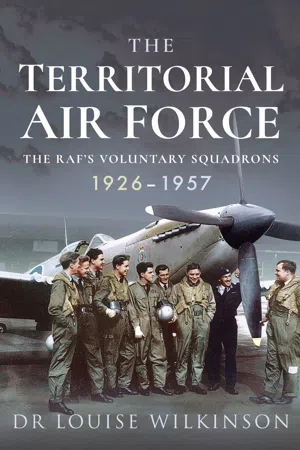
- 264 pages
- English
- ePUB (mobile friendly)
- Available on iOS & Android
About This Book
"What is almost certainly the definitive account of the Auxiliary Air Force, the Special Reserve and the Royal Air Force Volunteer Reserve." —Paul Nixon, Army Ancestry Research To date, little has been written about the Territorial Air Force as a voluntary military organization and no sustained analysis of its recruitment and social composition undertaken. Made up of three different parts, the Auxiliary Air Force, the Special Reserve and the Royal Air Force Volunteer Reserve, these three separate and different groups have not featured significantly in existing literature. Along with a history of the Territorial Air Force, this book includes an analysis of how the volunteers joined, and what kinds of men were accepted into the organizations as both pilots and officers. The influences class and social status had on recruitment in the run up to the Second World War are also discussed. There is an exploration of the key differences between the Auxiliary squadrons and the SR squadrons, as well as the main reasons for the idea of merging the SR squadrons into the AAF squadrons. Briefly discussed are the newly formed University Air Squadrons that were set up to promote "air mindedness" and to stimulate an interest and research on matters aeronautical. Military voluntarism continued to play a key role in the defense of twentieth-century Britain, and class ceased to be the key determining factor in the recruitment of officers as the organizations faced new challenges. Within both the AAF and the RAFVR the pre-war impression of a gentlemen's flying club finally gave way to a more meritocratic culture in the post-war world.
Frequently asked questions
Information
Table of contents
- Cover
- Title
- Copyright
- Contents
- Acknowledgements
- Acronyms
- List of Illustrations
- List of Tables
- Abstract
- Introduction
- Chapter 1 The Creation of the Reserve Forces
- Chapter 2 The Recruitment Process of the Territorial Air Force 1925–1939
- Chapter 3 The Social Composition of the Territorial Air Force Prior to 1939
- Chapter 4 The War Years
- Chapter 5 The Reconstitution of the Territorial Air Force 1946–1957
- Chapter 6 The Social Composition of the Territorial Air Force after 1945
- Conclusion
- Appendix 1
- Appendix 2
- Appendix 3
- Bibliography
- Endnotes
- Plate section